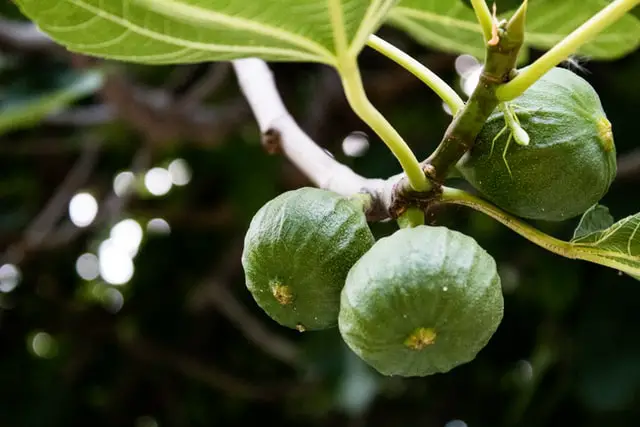Bring a touch of the Mediterranean into your garden with your very own dwarf fig tree. Hardy and compact, fig trees do very well in the UK climate despite their tropical heritage. Figs have so many health benefits and make a great snack or a tasty accompaniment to a meal.

Dwarf fig trees produce food yields of fruit during August and September where you are treated to the purple and brown fruits. Fig trees don’t technically produce blossoms but you do see lovely bold green leaves before the fruit grows. Some fig tree varieties actually produce two crops per year. Perfect for even the tiniest garden or balcony, potted fig trees won’t be much taller than 1.8 metres.
Jump To...
Best Dwarf Fig Tree Varieties
There is a plethora of information online when it comes to reading up on fig varieties to plant. We hope to make the process much smoother by sharing the best dwarf fig tree varieties as purchased by UK shoppers.
Little Miss Figgy
Producing sweet and juicy figs, Little Miss Figgy trees are hardy and also very small so slot nicely into a minimalist setting.
The figs are a delightful purple colour and make an attractive tree until they are ready to eat. Little Miss Figgys are perfect when baked with mascarpone.
- Best Feature: Capable of producing multiple crops in one year
- When To Plant Out: November to March
- Harvest Fruit: Autumn and potentially spring in warm weather
- Best Growing Position: Full sun
Brown Turkey
A sizable fruit full of sweetness, brown turkey fig trees produce one, perhaps two, crops a year.
Starting off green and then turning purple, inside you’ll find a pink flesh. They are wonderful to enjoy fresh from the tree or you could make some fig jam.
- Best Feature: Rich and sweet
- When To Plant Out: November to March
- Harvest Fruit: August and September
- Best Growing Position: Full sun
Growing Dwarf Fig Trees
Never discount growing your own fig tree on the grounds you aren’t a confident gardener. Fig trees are a great starter for any aspiring green fingered person. They are compact thanks to their dwarfing rootstock and their upkeep is fairly straightforward too. They grow well in a pot or window box or can be put in the ground.
- What Size Pot for a Fig Tree? Start in 30cm diameter but repot every 2 years to a bigger size
- Compost: Any soil with good drainage
- Watering: Daily during the summer months
- Feeding: Liquid tomato fertiliser fortnightly during the growing season
Common Dwarf Fig Tree Problems
- Red Spider Mites: These insects are often found on garden plants and if there is a large number of them you may notice some webbing. They are actually yellow and green in colour, despite their misleading name. Leaves can die and fall prematurely if left untreated. Regular sprays of water will help to control red spider mites.
- Overwatering: It can be very tempting to overwater your fig tree thinking it’s better than letting it become too dry. Whilst it’s important to keep it moist, too much water can do irreparable damage. It can cause leaves to fall early and therefore the crop size will be affected. Create good drainage in your pot so that the tree is not sitting in a pool of water.
Pruning Dwarf Fig Trees
There isn’t much to do throughout the year when it comes to owning a dwarf fig tree. You can even move it indoors during the cold weather instead of worrying about frost damage. Any pruning will be to maintain the health and shape of your fig tree.
When to Prune Dwarf Fig Trees
A good time to prune your dwarf fig tree is after the fruiting season so late August or September. You may want to resolve any overcrowding before this time, perhaps in the spring months.
How to Prune Dwarf Fig Trees
The main aim of pruning a containerised fig tree is to maintain its open crown shape which allows plenty of light in. Any diseased or weak branches should be removed so that the tree can focus its energy on the growing process.
FAQ’s
The beauty of fig trees is that they can be grown in containers, making them a great feature of a small patio. Due to their compact size, they can be moved indoors during harsh weather conditions.
Most dwarf fig trees will reach a height of 1.8 metres and yet still produce an abundance of food-sized figs.
Dwarf trees will tolerate most soil types as long as they are well drained and of a good quality.


You mention M27 rootstock in this online article about figs: this is a dwarfing apple rootstock, not a fig one. Though genetic dwarfs of figs do exist, as far as I know figs are not grafted onto dwarfing rootstocks. The best way to reduce the size of a fig tree is through restricting the roots, e.g. growing in a large pot.
Hi Mike, Our content is updated using templates for our editors to use, and it appears there was an error on this piece. We’ve now edited it. Thank you so much for flagging it, we appreciate your contribution to our info quality!